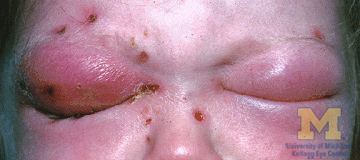Specialty ophthalmology ICD-9-CM 376.01 MedlinePlus 001012 | ICD-10 H05.0 DiseasesDB 9249 eMedicine article/1217858 | |
 | ||
Orbital cellulitis is inflammation of eye tissues behind the orbital septum. It most commonly refers to an acute spread of infection into the eye socket from either the adjacent sinuses or through the blood. It may also occur after trauma. When it affects the rear of the eye, it is known as retro-orbital cellulitis.
Contents
- Signs and symptoms
- Causes
- Treatment
- Prognosis
- Death and blindness rates without treatment
- Complications
- References
It should not be confused with periorbital cellulitis, which refers to cellulitis anterior to the septum.
Signs and symptoms
Common signs and symptoms of orbital cellulitis include pain with eye movement, sudden vision loss, chemosis, bulging of the infected eye, and limited eye movement. Along with these symptoms, patients typically have redness and swelling of the eyelid, pain, discharge, inability to open the eye, occasional fever and lethargy. It is usually caused by a previous sinusitis. Other causes include infection of nearby structures, trauma and previous surgery.
Causes
Orbital cellulitis occurs commonly from bacterial infection spread via the paranasal sinuses. Other ways in which orbital cellulitis may occur is from infection in the blood stream or from an eyelid skin infection. Upper respiratory infection, sinusitis, trauma to the eye, ocular or periocular infection and systemic infection all increase one's risk of orbital cellulitis.
Staphylococcus aureus, Streptococcus pneumoniae and beta-hemolytic streptococci are three bacteria that can be responsible for orbital cellulitis.
Treatment
Immediate treatment is very important for someone with orbital cellulitis. Treatment typically involves intravenous (IV) antibiotics in the hospital and frequent observation (every 4–6 hours). Along with this several laboratory tests are run including a complete blood count, differential, and blood culture.
Prognosis
Although orbital cellulitis is considered an ophthalmic emergency the prognosis is good if prompt medical treatment is received.
Death and blindness rates without treatment
Bacterial infections of the orbit have long been associated with a risk of catastrophic local sequelae and intracranial spread.
The natural course of the disease, as documented by Gamble (1933), in the pre-antibiotic era, resulted in death in 17% of patients and permanent blindness in 20%.
Complications
Complications include hearing loss, blood infection, meningitis, cavernous sinus thrombosis, and optic nerve damage (which could lead to blindness).
